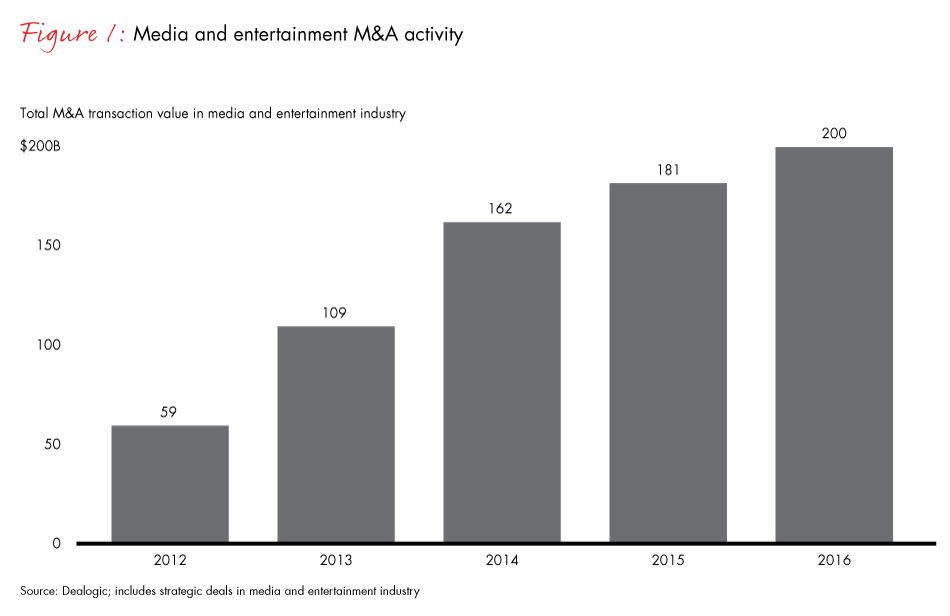Brief
 }
}
A host of trends are redefining today’s media landscape. The line between content creators and distributors continues to blur, changes in consumption patterns are accelerating, advanced technologies are being adopted in rapid cycles, and new competitors are constantly emerging. As the industry quickly evolves, we predict that more media companies will turn to mergers and acquisitions and that deal values will continue to rise. In 2012, the total value of media deals was less than $60 billion. That value reached $200 billion in 2016 (see Figure 1). While there will be a few targeted scope deals that merge distributors and content creators, such as the proposed AT&T–Time Warner merger, the majority will be scale deals aimed at combining networks or MSOs to benefit from synergies.
Scale deals make sense. In fact, for a media executive, there often is no more consistent way to spur growth and shareholder returns. When successful, these deals allow media companies to reset their cost base and increase negotiating power. Yet capturing this value is no small task. Bain research shows that most deals fail to deliver the cost synergies assumed at announcement. Systems complexities, increased attrition, cultural differences and lack of focus (among other common issues) can make it difficult to capture anticipated synergies.
Media companies that invest in strong merger integration capabilities and follow best practices can boost the odds of success so as to meet or exceed synergy targets. Most of these deals, however, will not have a material effect on the combined company’s multiple. The deals will get credit for taking costs out of P&Ls, but without a strategic shift in the new company’s position, its multiple is not likely to change. There is a way, though, to achieve extraordinary multiple expansion: It requires management teams to view a deal as a substantive and defining moment for change.

There are three approaches to achieve this; we will look at them one by one.
-
Develop a new relationship with your consumer. Acquisitions provide a unique opportunity for companies to change their approach to reaching the consumer. For example, after achieving a certain scale, two merged networks may be in a position to develop a direct-to-consumer offering that has a differentiated value proposition. Or two merged distributors could have the scale and footprint to open up new opportunities with emerging content or distribution models that attract new customer segments or deepen existing customer relationships. This approach requires a clear customer strategy roadmap—a tool that is critical for choosing the right targets as well as for integrating them in a way that takes full advantage of the combined portfolio.
-
Use integration to redesign the organization and benefit from broader industry shifts. There are few organizational disruptions greater than that occasioned by integrating two companies. Companies should use the natural disruption as a rare chance to implement a broader organizational change agenda and adjust their operating model to take advantage of industry shifts. See how disruption in traditional TV distribution models is compelling networks to build stronger relationships with their consumers. When two networks integrate, they can serve as a catalyst to adapt legacy operating models to the new realities. Both companies’ operating models may have been honed to serve a business-to-business environment; now these can be designed to be more consumer centric. Integration creates the opportunity to establish new roles, hire different talent, reimagine incentive structures, reset ways of working and reallocate IT budgets to support a more consumer-centric culture—a likely competitive advantage for the years ahead.
-
Accelerate the growth of a hidden asset. M&A can uncover hidden assets within each enterprise. For example, scale data assets and leading analytics capabilities are increasingly necessary to remain competitive in today’s video industry. These high-octane assets may have suffered from lack of investment in a smaller entity. In the combined company, they can be developed to spur significant growth.
Pursuing scale deals in media without using them as opportunities to expand multiples is akin to leaving value on the table. While generating efficiencies should definitely be core to any deal thesis or integration effort, executing on unique opportunities that can expand a company’s multiple will increasingly determine who wins and who loses in the rapidly evolving media landscape.
Adam Haller is a Bain & Company partner with the Mergers & Acquisitions and Technology practices, and he is based in San Francisco. Daniel Hong is a Bain partner with the Media and Technology practices, and he is based in New York.